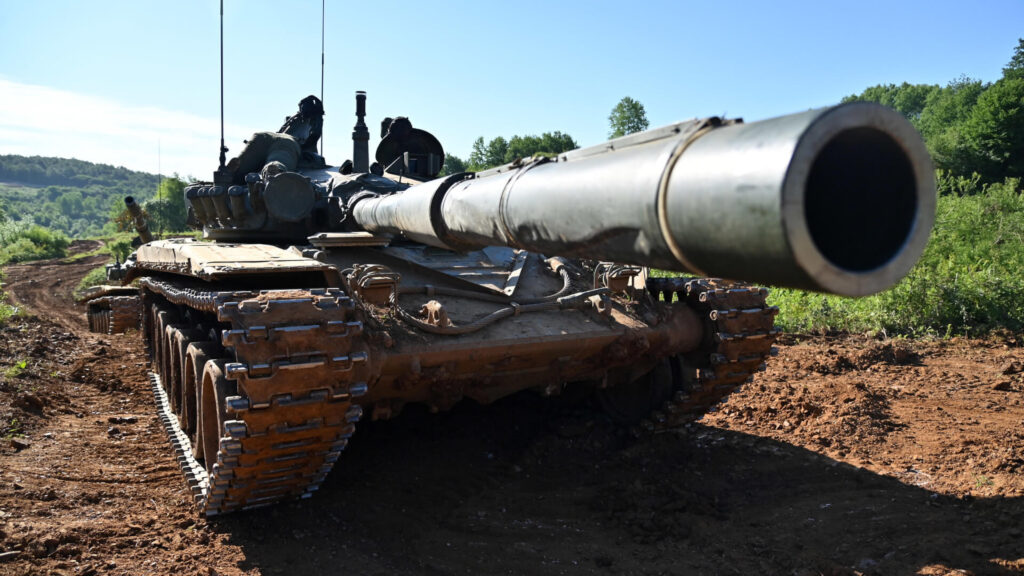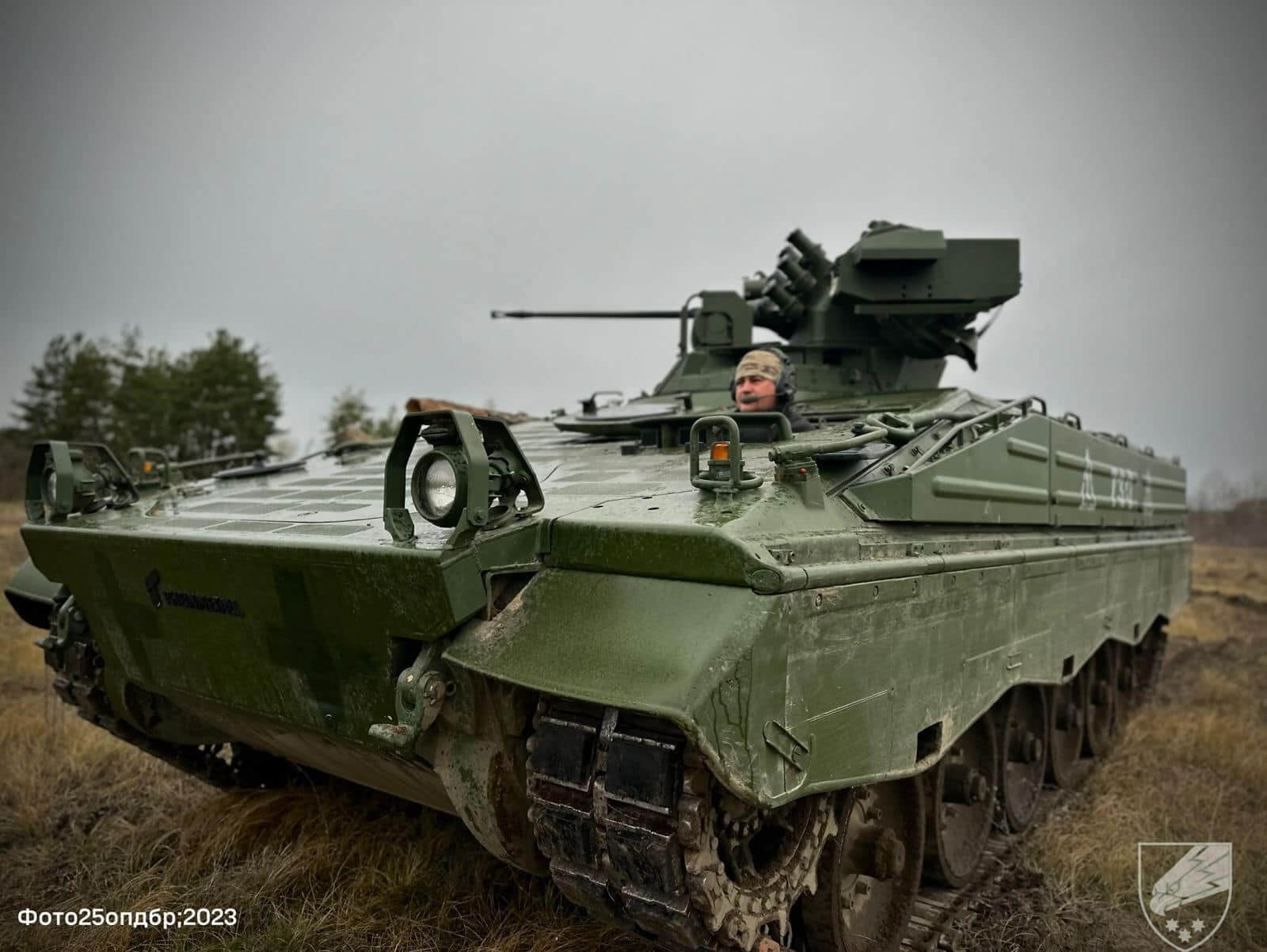Over the past years, Germany’s assistance to Ukraine with military equipment has become increasingly diverse.
Today, Germany not only supports Ukraine on a bilateral level like most other countries and is contributing to multilateral initiatives like the Czech ammunition initiative (largest donor country), but also clearly sets itself apart from other countries with its own less known Ringtausch programme.
Roughly translated, it means “circular exchange” and thus describes very clearly how this programme works. In principle, it is a straightforward to understand concept.
Instead of direct deliveries to Ukraine by Germany, the latter supplies relatively modern military equipment such as trucks, main battle tanks or similar to a third country, which in return delivers older, mostly Soviet-made equipment to Ukraine.
The advantage is that the Ukrainian military will be supplied comparatively fast with material with which it is already familiar and which can therefore be deployed fairly quickly in the fight against the Russian aggressor.
In other words, this usually avoids having to deal with long production times or potentially time-consuming overhauls or maintenance by the industry and the subsequent weeks of training for Ukrainian soldiers.

Of course, the Ringtausch programme also has advantages for Germany and the third countries involved. Third countries can replace their older military material with relatively modern German-made material at no direct cost.
For the German industry, this means one thing above all: revenue. On the one hand, there is a direct contract from the German government and on the other hand, third countries involved are bound to the German arms industry for a more or less long period of time.
A simple but unpopular concept
Nevertheless, this concept also has its flaws and is not so highly valued by many people, especially in Ukraine.
The Ukrainian ambassador to Germany, Oleksii Makeiev, said in July 2023 at Zeitenwende on tour in Berlin that there were maybe two very unpopular words in 2022 for him and one of them was “Ringtausch”.
The big problem here is that most Ukrainians or supporters of Ukraine think that the AFU could have very well-used the modern German-made systems like Leopard 2 MBTs or Marder IFVs for itself, instead of being supplied with older Soviet-made systems.
Of course, I can understand this thought, and I’m not saying that these people are wrong. I just want to point out that the Ringtausch deals were mostly concluded at a time when Germany, for example, was not making bilateral deliveries of main battle tanks and infantry fighting vehicles to Ukraine.
Of course, this brings us back to the debate whether there shouldn’t have been bilateral deliveries of MBTs and IFVs as early as 2022, but everything has been said about that and I doubt that many people have an opinion other than that: Yes, there should have been.
Nevertheless, I still believe that under the circumstances at the time, the Ringtausch programme was the best way to deliver various equipment to Ukraine relatively quickly and to encourage other countries to make deliveries.
The Ringtausch deals in detail
The list of countries that have already supplied equipment to Ukraine via the German Ringtausch programme has grown continuously since 2022.
There are now six countries: Croatia, the Czech Republic, Greece, Portugal, Slovakia, and Slovenia. Let’s have a closer look at all the known deals.
Croatia
The first Ringtausch deal we are looking at is also the last one to be concluded. In October 2024, just about three months ago, Germany and Croatia agreed on the delivery of 30 M-84A4 MBTs as well as 30 M-80 IFVs both with ammunition and spare parts from Croatian army stocks to Ukraine.

In return, Croatia received around €144 million from Germany, which it intends to use to procure up to 50 German-made Leopard 2A8 MBTs. Quite an upgrade!
The delivery of the 60 vehicles to Ukraine was completed within a couple of weeks by the end of 2024, the deal therefore signed and completed within a very short time. A perfect example of how the Ringtausch process should work.
Czech Republic
The German government has already arranged two Ringtausch deals with his neighbouring country, which is by now particularly well known for its own ammunition initiative.
The initial Ringtausch deal between Germany and the Czech Republic was announced back in May 2022. Germany’s participation was 14 Leopard 2A4 MBTs along with spare parts and ammunition as well as 1 Bergepanzer 3 ARV, while the Czech Republic was to supply 20 T-72M1 MBTs to Ukraine in return.
However, already months before the public announcement of the Ringtausch deal, the Czech Republic had already delivered around 40 T-72M1 MBTs to Ukraine, so it is quite possible that this delivery was not directly tied to a German compensation, although Czech officials were of course happy to accept this.
Around two years later, the Czech government made a second deal with Germany public. Germany’s involvement in the deal was once again the same, while nothing is currently known about the Czech Republic’s deliveries to Ukraine.
Although it’s of course quite possible that they are once again being compensated for the delivery of 20 T-72M1 MBTs.
Greece
Next up would be Greece, whose Ringtausch deal was made public in September 2022. Greece has received a total of 40 Marder 1A3 IFVs along with spare parts and ammunition from Rheinmetall and in return delivered the same amount of BMP-1A1-Ost IFVs to Ukraine, starting in October 2022.

However, the German deliveries to Greece, as well as the Greek deliveries to Ukraine, have dragged on quite a bit, which certainly had to do with the fact that Rheinmetall was practically continuously busy with the overhaul and delivery of Marder 1A3 IFVs directly to Ukraine since the beginning of 2023 and no spare capacity was available.
Portugal
Let’s move on to a deal that is not officially classified as a Ringtausch, but I can’t describe it any other way, so at least I do count it as one.
As is no doubt well known by now, there were countless discussions in the weeks before and after the announcement that the delivery of German-made Leopard 2 MBTs to Ukraine would be approved.
One of the countries where there was some uncertainty was Portugal. At the beginning, it was repeatedly claimed that the Portuguese Leopard 2A6 MBTs were not in good condition and that a replacement had to be found before a delivery to Ukraine could take place.
In the end, however, the Portuguese government agreed to the delivery of 3 Leopard 2A6 MBTs. However, the approval apparently had a catch which was not known for more than half a year.
According to documents of the Portuguese government, which were only made public in December 2023, the Portuguese Ministry of Defence had been in negotiations with the German Ministry of Defence for several months.
In the end, it was agreed that Germany would finance the maintenance of the remaining Portuguese Leopard 2A6 fleet in active service (14 MBTs) with €20 million as a compensation for the delivery of the 3 Leopard 2A6 MBTs to Ukraine.
Slovakia
Just like the Czech Republic, Slovakia concluded two Ringtausch deals with Germany. However, for whatever reason, the first one is no longer officially labelled as a Ringtausch, although it was announced as such in 2022.
Shortly after the Russian invasion of Ukraine began, Slovakia delivered an S-300PMU battery to Ukraine. This was a vital piece of support for the Ukrainian air defence forces, which are still under enormous pressure today.
Shortly afterwards, Germany, among others, stationed an army company and two MIM-104 Patriot fire units in Slovakia for many months, which were later withdrawn.
In autumn 2023, Germany delivered 2 MANTIS air defence systems and 5 LÜR air surveillance radars to Slovakia free of charge to finally complete the Ringtausch.

The second Ringtausch deal, which was made public in August 2022, involved the delivery of 30 BVP-1 IFVs to Ukraine in exchange for 15 Leopard 2A4 MBTs along with spare parts and ammunition. Both the deliveries to Ukraine and the deliveries to Slovakia were completed a long time ago.
Slovenia
Last but not least, Slovenia! In mid-September 2022, Germany and Slovenia agreed on the delivery of 28 highly modernised T-55 MBTs, so-called M-55S, from Slovenian stocks to Ukraine.
In return, Germany was to supply 40 HX 8×8 trucks along with 35 swap-body platforms and 5 water tanks to Slovenia. According to the German Ministry of Defence, Slovenian officials have explicitly requested this material.
These deliveries have also long since been completed.
In absolute figures, this means that 100 IFVs, at least 81 MBTs and a single SAM system were delivered to Ukraine through or in connection with the German Ringtausch programme. I’ve also summarised this below in a table in case you are interested in it.
| Germany’s contribution to third party country | Third party country’s contribution to Ukraine |
|---|---|
| €144 million (to be used for the procurement of Leopard 2A8 MBTs) | Croatia: 30 M-84A4 MBTs, 30 M-80 IFVs both with ammunition and spare parts |
| 14 Leopard 2A4 MBTs along with spare parts and ammunition, 1 Bergepanzer 3 ARV | Czech Republic: 20 T-72M1 MBTs |
| 14 Leopard 2A4 MBTs along with spare parts and ammunition, 1 Bergepanzer 3 ARV | Czech Republic: ? |
| 40 Marder 1A3 IFVs along with spare parts and ammunition | Greece: 40 BMP-1A1-Ost IFVs |
| €20 million (for the maintenance of the active Portuguese Leopard 2A6 MBT fleet) | Portugal: 3 Leopard 2A6 MBTs |
| 15 Leopard 2A4 MBTs along with spare parts and ammunition | Slovakia: 30 BVP-1 IFVs |
| 2 MANTIS air defence systems, 5 LÜR air surveillance radars | Slovakia: 1 S-300 SAM system |
| 40 HX 8×8 trucks along with 35 swap-body platforms and 5 water tanks | Slovenia: 28 M-55S MBTs along with spare parts |
For me personally, the figures speak for themselves. In my opinion, the Ringtausch programme is not perfect and it is still debatable, but I don’t think it was a mistake, and it enabled the rapid delivery of a number of military equipment that Ukraine would probably never have received otherwise.
If you liked this post, consider following me on X, Bluesky, or Telegram. If you like, you can also leave me a tip on Ko-fi.
Changelog
- 27th of January 2025 — After more than a year and several additional concluded Ringtausch deals, I have rewritten and updated the entire article


